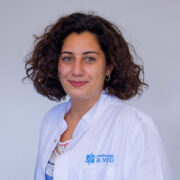
Biographical notes
Marianna Barbuto is a PhD Student in “Technology and Science for Human Health” at the University of Palermo in collaboration with Ri.MED Foundation. She received Bachelor’s and Master’s degree (2017) in Biomedical Engineering (curriculum Cells, Tissues and Biotechnology) at the Polytechnic University of Milan (Milan, Italy). Thanks to a competitive scholarship, she spent 6 months as a visiting student at Radboud University Medical Center (Regenerative Biomaterials Research Group) (Nijmegen, The Netherlands) working on hydrogels fabrication and characterization for tissue engineering applications.
Before starting her PhD, she worked at Cardiological Research Hospital “Monzino” (Milan, Italy) where she exploited the potential of the bioprinting technique to design disease in vitro models and 3D cell culture. Moreover, she was involved in the development of a controlled recellularization process of porcine pericardium to obtain a living valve-like tissue.
Scientific activity
Marianna’s PhD project is currently focused on the fabrication and the in vitro/in vivo characterization of a three-layered bio-inspired tissue engineering small-diameter vascular graft (TEVG). The new generation of TEVG aims to mimic the structure/function of native vessels, minimize intima hyperplasia and improve long-term clinical outcomes by enhancing the endothelialization of the lumen due to specific fibrous patterning at the mesoscale. Since May 2022, she is conducting her project at the McGowan Institute for Regenerative Medicine, University of Pittsburgh (Pittsburgh, USA).
Her skills include biomaterials characterization (FT-IR, scanning electron microscopy, uniaxial test, suture retention test, rheology), bioprocessing techniques for tissue engineering application (electrophoretic deposition of organic and inorganic biomaterials, electrospinning, thermally induce phase separation, bioprinting), decellularization of animal tissue (pericardium, aorta, heart, small intestine submucosa), cell culture techniques (3D cell culture, dynamic culture through a bioreactor), biological tissue characterization (histology), imaging analysis (ImageJ, MatLab).
